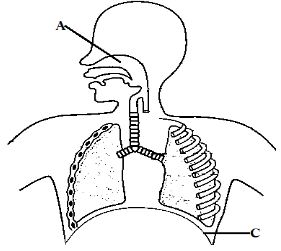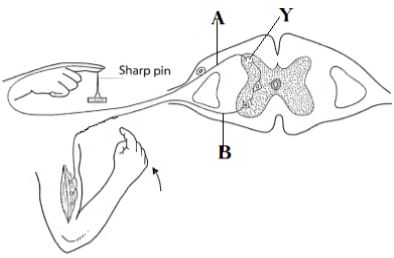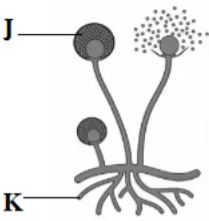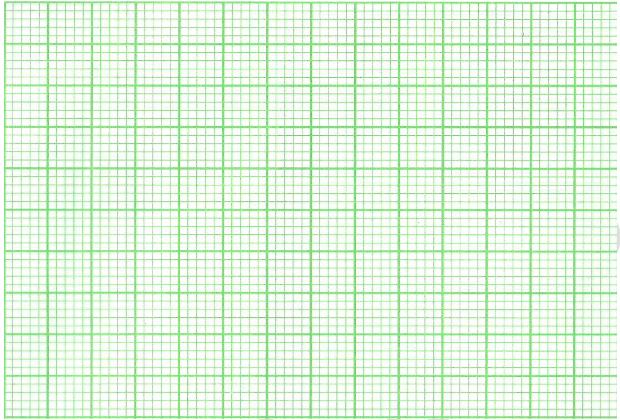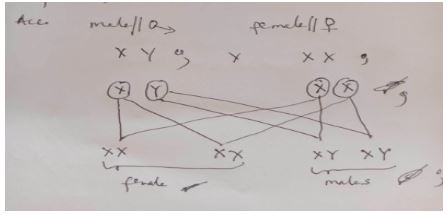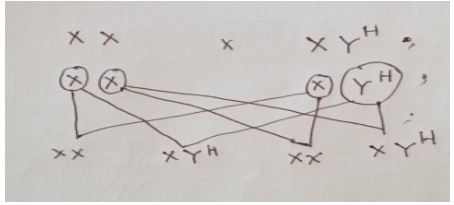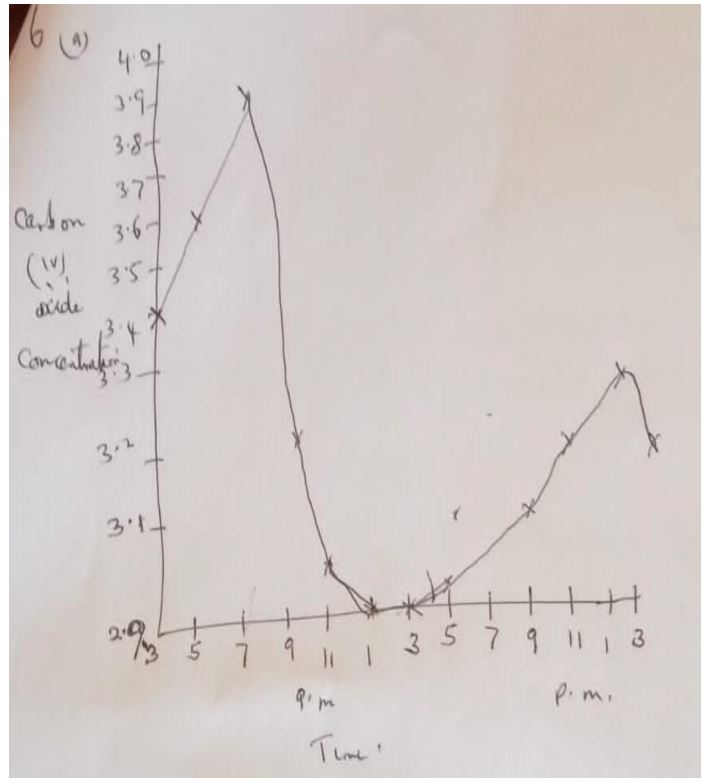- This paper consists of two sections: A and B. Answer ALL questions in section A in the spaces provided. In section B, answer question 6 (compulsory) and either question 7 or 8 in the spaces provided after question 8.
Section A (40marks)
Answer all the questions in this section in the spaces provided.
- The diagram below represents the human respiratory system.
- How is structure labelled A adapted to its function? (4 marks)
- What would be the effect of contractions of the muscles of the structure labelled C during breathing in. (3 marks)
- Give the scientific name of the organism that causes whooping cough? (1 marks)
- The diagram below represents a section of the spinal cord.
- State one structural and functional differences between A and B. (2 marks)
Structural
Functional - State three differences between a simple and a conditioned reflex? (3 marks)
- Explain how an impulse is transmitted across region Y? (3 marks)
- State one structural and functional differences between A and B. (2 marks)
- Form 3 students were assigned to study a particular ecosystem around the school.
- Distinguish between an ecosystem and ecological niche. (2 marks)
- Name a suitable method they would have used to estimate the population of wild animals. (1 marks)
- State three methods which could be used to determine the diet of the wild animals. (3 marks)
- Name biotic factors that could have regulated the animal population? (2 marks)
-
- How is sex in humans determined. (3 marks)
- In human, hairy ears is controlled by a gene on the Y chromosome. Using letter YH to represent the chromosomes carrying the gene for hairy ears, work out a cross between a hairy eared man and his wife. (4 marks)
- Girls will not display hairy ears, explain. (1 mark)
- The diagram below illustrates the structure of bread mould.
- State the function of the structure labelled K. (2 marks)
- Describe the mode of reproduction. (5 marks)
- State any one economic importance of members of this kingdom (1 mark)
SECTION B
Answer question 6 (compulsory) and either question 7 or 8 in the space provided after question 8.
- In an experiment carried out in a tropical country, carbon (IV) oxide concentration was measured around a plant in an open air at two hours in travels for a period of 24 hours. The results were as shown in the table below.
Time % of CO2 concentration(x10-2) 3am 3.40 5am 3.60 7am 3.90 9am 3.20 11am 2.95 1pm 2.90 3pm 2.90 5pm 2.92 7pm 3.02 9pm 3.10 11pm 3.20 1 am 3.30 3 am 3.40 - Plot a graph of % carbon (IV) oxide concentration against time on the grid provided. (5 marks)
- Calculate the rate of change in CO2 concentration between 4 a.m. and 7 a.m. (2 marks)
- Give a reason for the change in CO2 concentration between:-
- 7 a.m. to 11a.m (2 marks)
- 12 noon to 4 p.m. (2 marks)
- 5p.m. and 5 a.m. (3 marks)
- With reasons identify three environmental factors that are likely to affect the results. (6 marks)
- Plot a graph of % carbon (IV) oxide concentration against time on the grid provided. (5 marks)
- Describe how the male reproductive system is adapted to perform its functions. (20 marks)
- Explain the role of the following hormones in growth and development:
-
- Indole acetic acid. (5 marks)
- Gibberellin. (5 marks)
- Cytokinnin. (5 marks)
- Describe role of hormones in insect metamorphosis. (5 marks)
-
MARKING SCHEME
Section A (40marks)
Answer all the questions in this section in the spaces provided.
- The diagram below represents the human respiratory system.
- How is structure labelled A adapted to its function? (4mks)
- Has hairs to filter solid particles
- Has mucus secreting cells to trap solid particles dust
- Has numerous blood vessels /capillaries to warm //moisten in cooling air
- Has olfactory/sensory cells to detect oduor / quality of air
- What would be the effect of the diaphragm muscle contraction during breathing in.(3mks)
- Diaphragm muscles flattens;
- Volume of thoracic cavity// lungs increase;
- Atmosphere pressure been higher than pressure inside;
- Forces air to rush into the lungs;
- Give the scientific name of the organism that causes whooping cough? (1mks)
- Bordattella pertusis
- How is structure labelled A adapted to its function? (4mks)
- The diagram below represents a section of the spinal cord.
- State one structural and functional Differences between A and B.(2mk)
- Structural (any 1mks)
A//sensory neuron B//motor neuron Cell body situated of axon Cell body at one end of axon Cell body outside cells Cell body in CNS Receptors dendrites located in sense organs while terminal dendrite located in CNS Motor end plate terminates in a muscle// gland - Functional 1 mks
A//sensory neuron B//motor neuron Transmit nerve impulse from sense organs to CNS Transmit nerve impulse from CNS to effector
- Structural (any 1mks)
- State 3 differences between a simple and a conditioned reflex? (3mks)
Simple reflex Conditioned reflex Single stimulus to bring about response Repeated stimulus to about response Simplest form of behavior and is independent of experience Involves modification of behavior and dependent on experience Sensory and motor components are the same at all times. Primary sensory is replaced by a secondary sensory components but the motor components remain unchanged. - Explain how an impulse is transmitted across region y? (3mks)
- When an impulse reaches synoptic knob it stimulates vesicles to move towards the pre-synoptic membrane; releasing acetylcholine// transmitter substance
- Transmitter substance makes membrane permeable;
- Transmitter substance diffuses across the synaptic cleft to post synaptic membrane which is then depolarized// causing an action potential; Max 3
- State one structural and functional Differences between A and B.(2mk)
- Students of Furaha Mixed Secondary School were assigned to study a particular ecosystem.
- Distinguish between ecosystem and ecological niche? (2mks)
ecosystem Ecological niche Natural compound composed of abiotic and biotic factors whose interactions lead to a self-sustaining system Position organism occupies in a habitat// physical space where an organism is found// role in habitat in terms of feeding relationship and other interaction with other species - Name suitable method they would have used to estimate the population of wild animals? (1mks)
- Aerial count// total count// quadrant// bell transect// capture-recapture/ aerial photography.
- Animals are mobile;
- State 3 methods which could be used to determine the diet of the wild animals? (2mks)
- Observation
- Examining the dropping
- Analyze gut content
- Study dentition//beaks// claws// mouth parts
- Dissecting a sample of the animal// examine structure of digestive system // no of stomach chambers// size of caecum// large intestine
- Name biotic factors that could have regulated the animal population? (2mks)
- Immigration//emigration/migration
- Competition
- Predation
- Parasitism
- Diseases
- Poaching// hunting// curling//any human activities//man
- Distinguish between ecosystem and ecological niche? (2mks)
-
- How is sex in humans determined? (3mks)
- males have X and Y // heterogametic
- females have X and X // homogametic
- sperms have either X OR Y, while all female gametes have y chromosomes
- if a sperm with x fuses with an ovary x a male
- In human’s hairy ears is controlled by a gene on the Y chromosome.
Using letter Y to represent the chromosomes carrying the gene for hairy ears, work out a cross between a hairy eared man and his wife? (4mks)
- Girls will not display hairy ears, explain? (1mk)
- Girls are XX and gene for hairy ears is only found in Y chromosome;
- How is sex in humans determined? (3mks)
- The diagram below illustrates the structure of bread mould.
- State the function of the structure labelled K? (2mks)
- Absorption of soluble substance // digest nutrients;
- Secretion of digestive enzyme
- Anchorage;
- Describe the mode of nutrition? (5mks)
- Reproduce asexually; by sporulation; − Spores develop from a single cell sporangium; which burst on maturity releasing spores; which are dispersed by air currents // wind; germinating to form new generation// form mycelium
- State any one economic importance of members of this kingdom? (1mk)
- Food spoilage
- Food (mushroom)
- Baking
- Brewing
SECTION B
Answer question 6 (compulsory) and either question 7 or 8 in the space provided after question 8
- State the function of the structure labelled K? (2mks)
- In an experiment carried out in a tropical country, carbon iv oxide concentration was measured around a plant in an open air at two hour in travels for a period of 24 hours
Time % of CO2 concentration(x10-2) 3am 3.40 5am 3.60 7am 3.90 9am 3.20 11am 2.95 1pm 2.90 3pm 2.90 5pm 2.92 7pm 3.02 9pm 3.10 11pm 3.20 1 am 3.30 3 am 3.40 - Plot a graph of % carbon (iv) oxide concentration against time on the grid provided. (5mks)
- Calculate the rate of change in CO2 concentration between 4 a.m. and 7 a.m. (2mks)
- Give a reason for the change in CO2 concentration between:-
- 7 a.m. to 11a.m (2mks)
- Rapid decrease in CO2 concentrations due to utilization of CO2 in photosynthesis; CO2 concentration
- 12 noon to 4 p.m. (2mks)
- remains almost constant; photosynthesis rate equals respiration rate // compensation point
- 5p.m. and 5 a.m. (3mks)
- Increase in CO2 concentration; the rate of photosynthesis drops stops respiration produces CO2 which accumulates
- 7 a.m. to 11a.m (2mks)
- With reasons identify 3 environmental factors that are likely to affect the results (6mks)
- Wind – blow CO2 avoiding accumulation of CO2;
- Sunlight − affects the rate of photosynthesis hence rate of CO2 consumption;
- Temperature − affects the rate of photosynthesis and therefore CO2 around the plant.
- Humidity – affects stomatal openings and closing of stomata affecting movement of CO2 around the plant. Any 2
- Plot a graph of % carbon (iv) oxide concentration against time on the grid provided. (5mks)
- Describe how the male reproductive system is adapted to perform its functions (20mks)
- Penis; erectile tissue // spongy tissue mussels and blood vessels; filled with blood for erection;
- Glands − has sensitive nerve ending; stimulation results to granulation;
- Seminiferous tubules: -
- long coiled − to provide a large surface are for sperm production.
- Inner lining has actively dividing cells – give rise to sperm
- Sertoli cells – nourish sperms
- Inter − glandular//secretes; androgens// testosterone
- Testis – outside body in scrotal sac; provide cooler environment for sperm production.
- Epididymis – highly coiled; to store sperms
- Vasdeferens// sperm duct – narrow tube; connecting epididymis with urethra // ejaculation duct;
- Seminal vesicle // prostate gland // cowpers glands// bulbs urethral gland
- Provide sperms with nutrients
- Has alkaline fluid to neutralize acid in vagina // urethra max 20
- Explain the role of the following hormones in growth and Development
-
- Indoleacetic acid (5mks)
- cell division // elongation
- Influence tropic movement
- Fruit formation// pathenocapy
- Decrease in IAA promotes formation of abscission layer// bringing leafs to fall
- Cell differentiation
- Cause growth of adventurous roots
- Cause apical dominance
- IAA+ cytokinnins induces cellos hormones
- Gibberellin (5mks)
- Cell division//cell elongation in dwarf plants
- Initiates formation of IAA// Parthenocarpy// setting of fruits after fertilization.--Formation of side branches of stems//seed dormancy(in buds)
- Inhibits growth of adventitious roots .
- Activates hydrolytic enzymes during germination//Promotes germination of cells //breaks seed dormancy;
- Affects leaf expansion and shape//Retards leaf abscission;
- Cytokinnin (5mks)
- Breaks dormancy
- Promotes cell division
- Promote root formation of a shoot
- Low concentration encourages leaf
- Normal concentration increases increases cell enlargement in leaf
- Promotes flowering
- Stimulates lateral bond development
- Indoleacetic acid (5mks)
- Describe role of hormones in insect metamorphosis.( 5mks
- During larval stage Corpora Allata produces Juvenile hormone; leads to formation of larval cuticle; when the larva matures ,Corpora Allata disintegrates lowering level of juvenile hormone; this stimulates neuro secretory cells to stimulate prothoraces gland ; to produce ecdysone responsible for maulting; leading to laying of adult cuticle.
-
Download Biology Paper 2 Questions and Answers - BSJE Mock Exams 2023.
Tap Here to Download for 50/-
Get on WhatsApp for 50/-
Why download?
- ✔ To read offline at any time.
- ✔ To Print at your convenience
- ✔ Share Easily with Friends / Students

